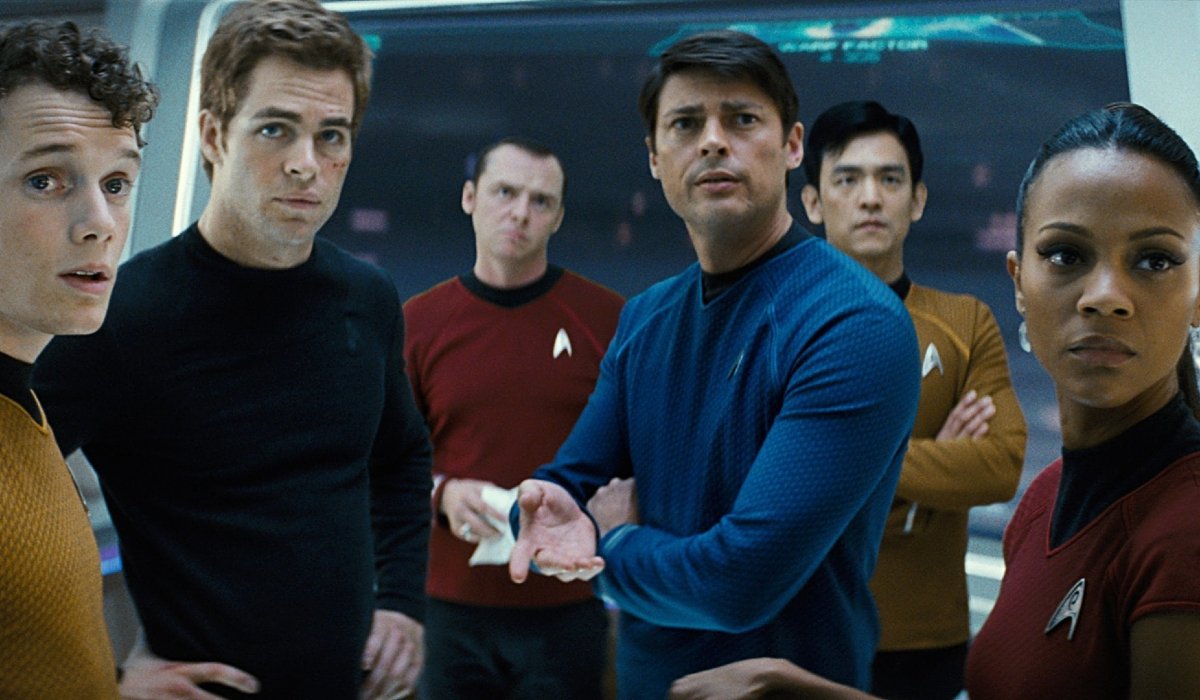How The 2009 Star Trek's Time Travel Works

Greetings fellow time travelers, and welcome back to the CinemaBlend labs! Don’t mind the mess you might see around you, as we’re still cleaning up after several attempts to dissect the complex nature of The Butterfly Effect’s rather gruesome travels. The bad news is, I lost many lab coats to that experiment; but the good news is, I’ve fully healed from the side effects after one final trip. (Sorry folks, but those Butterfly Effect sequels actually do need to exist… for reasons.) Anyhow, the past is in the past, and it’s time for us to boldly go from here to there in the then and now with Star Trek’s 2009 reboot; where a dreamy Chris Pine awaits his destiny, and box office glory.
But before we beam aboard the IMS Blenderprise, and take off into time, let’s tidy things up a little more around the lab. And by tidy up, I mean I’d like to remind you that not only can you head over to the CinemaBlend Time Travel Archives and see out complete collection of studies in time and space, you can also put in requests for the future adventures. We’re open to suggestions, and without them, we might not have gotten to Star Trek as quickly as we did. With those pleasantries out of the way, and a quick diversion to the space elevator, as our transporter won’t be installed until Thursday, it’s time to boldly go once more into Star Trek history.

The Time Travel in Star Trek
Space… the final frontier. At least, it was until Star Trek started playing around with time. This series has seen it all: slingshot maneuvers around the sun in order to save the whales, and sailing across a temporal wake so that the Borg didn’t prevent (Star Trek) First Contact. But in this latest example of cinematic clock turning, the very fundamentals of Gene Roddenberry’s iconic crew are challenged, thanks to some alternate history.
Who's Time Traveling?
Nero (Eric Bana) and the crew of the Narada, as well as Ambassador Spock (Leonard Nimoy,) aboard his experimental spacecraft, the Jellyfish.
From When To When
Both the Narada and the Jellyfish travel back from the far flung year of 2387, however they land at relatively different points in time. Nero and the Narada emerge in 2233, where they destroy the USS Kelvin and officially create the Kelvin Timeline. 25 years later, Ambassador Spock’s Jellyfish winds up in 2258, seeing these unintended foes square up yet again.
Your Daily Blend of Entertainment News
The Purpose Of Their Trip
The funny thing is, in a franchise like Star Trek that’s always embraced conscious acts of time travel, this adventure is a purely accidental jaunt down the timeline. While trying to save the planet Romulus from a supernova event, Ambassador Spock triggers perhaps the greatest temporal rift in Star Trek movie history.

How Time Travel Happens In Star Trek
Have you ever wanted to time travel, but also leave a horrific mess in your wake thanks to generating a black hole in the process? Then friends, Red Matter is the perfect way for you to get into some temporal trouble in the Star Trek universe. This is, quite possibly, the most haphazard method of time travel; and we’ve already covered 12 Monkeys’ pull and prey method of throwing travelers back in time like hand grenades.
Theoretically, Red Matter is a substance that’s supposed to generate a black hole; so in that respect, it does what it says on the tin. Just one drop is supposed to be able to, say, “collapse a star, or consume an entire planet.” So don’t put this stuff on your chili dogs, folks; because you won’t be the one who's getting fed in that scenario. However, as Ambassador Spock attempted to save Romulus from its sun going into supernova, the resulting black hole quelled that particular disaster too late to achieve its desired effect. Which lead to both Spock’s craft, the Jellyfish, and Nero’s craft, the Narada, being sucked into its vortex, and emerging at two different points in time.
Star Trek’s time travel is inexact, and it wasn’t even supposed to happen. It’s also a one-way trip back into the past, as there’s no way to exactly measure where or when you’re going to end up. So Ambassador Spock’s future will always lead him to the past, and a brand new version of its events, the moment he finally emerges from the black hole.

Can History Be Changed As A Result Of Time Travel In Star Trek?
History can definitely be changed in Star Trek, and we see an entire timeline created as a result. After Nero and the Narada take out the USS Kelvin, killing Captain George Kirk in the process, the Kelvin timeline branches off from that moment in 2233 and creates a tangent universe where a major studio can rebrand a legacy franchise all it wants, in the name of keeping it fresh. Which means that while we watch a younger Spock try to choke out a younger Kirk, we’re observing a timeline being rewritten in real time.
Though we do also see the presence of Ambassador Spock in Star Trek’s shiny new Kelvin timeline. Maintaining his memories of the future past, as well as the future, the classic Spock is able to help advise on certain events that have come to pass in the original timeline. Of course, he tries not to interfere too much, as that would be cheating; a fact that a younger Kirk would call him out on in the middle of saving Earth from Nero’s destructive scheme.
As if that wasn’t the epitome of Star Trek time travel shenanigans, we also see Montgomery “Scotty” Scott (Simon Pegg) being given his own equation for “Transwarp Beaming” by Ambassador Spock to help beam Mr. Scott and then First Officer Kirk onto the Enterprise. Since the good and future ambassador was present for Mr. Scott’s similar actions during Star Trek IV: The Voyage Home, that’s the most Trek way of proving that yes, history can change, especially when it’s convenient to the mission.

What Are The Consequences Of Time Travel In Star Trek?
For starters, transwarp beaming is a thing a lot earlier than one would have expected. But that’s merely the first consequence in the Kelvin Star Trek lore. On a more personal level, James Kirk’s father, George, never lives to see him become a captain. The original timeline for Star Trek events sees George Kirk dying at some point past 2265, the year where James becomes the captain of the USS Enterprise-A.
Throughout the events of the Kelvin Timeline trilogy, Star Trek would see new and exciting wrinkles present themselves in the timeline. Star Trek ‘09 saw the destruction of Vulcan, as well as the untimely death of Spock’s mother Amanda Greyson (Winona Ryder), two more major events that absolutely didn’t happen at this point in the franchise. In fact, we see Spock’s mother, as well as the planet Vulcan, alive and well throughout the series and films of Star Trek’s original timeline; which has Ms. Greyson passing in the year 2366.
The whole point of the Kelvin Timeline in Star Trek is to present a rebooted continuity where anything and everything can happen; and it continues to throughout its two sequels: Star Trek Into Darkness and Star Trek Beyond. One of the greatest examples of that sort of madness comes in that first sequel, where Captain Kirk sacrifices himself rather than Commander Spock, in order to save the Enterprise. Ultimately, this time travel madness might have sorted itself out in Star Trek IV; because Chris Pine’s James T. Kirk and Chris Hemsworth’s George Kirk were supposed to run into each other again, through some sort of temporal mayhem. But, of course, that’s an idea that’s probably dead in the water at this point, as both Chrises kind of had a bit of a dispute involving something even the Klingons cringe at: contract negotiations.

Thrusters On Full. Mr. Sulu, Take Us Out.
Well friends, we’ve just completed Star Trek’s Kelvin Timeline origin story! While there’s plenty more problems involving time travel in the Star Trek universe, for the moment they lie on the TV side of the house. So unless a rift opens between the world of TV and Movie coverage, we’ll be moving onto more cinematic adventures with temporal excitement. And our next installment is going to be exciting, as we’ve once again gotten away with traveling through time without destroying a ship!
I hope you’ve all got a bathing suit, wet suit, or other waterproof outfitting to wear, as it’s time to climb into the hot tub! Prepare yourselves, as we’re going to look into how the Hot Tub Time Machine duology uses time travel. Take all the time you need to restock your home bar, as well as hide all of your copies of Lisa Loeb’s “Stay” somewhere that these temporal shenanigans can’t erase them, and I’ll see you then!

Mike Reyes is the Senior Movie Contributor at CinemaBlend, though that title’s more of a guideline really. Passionate about entertainment since grade school, the movies have always held a special place in his life, which explains his current occupation. Mike graduated from Drew University with a Bachelor’s Degree in Political Science, but swore off of running for public office a long time ago. Mike's expertise ranges from James Bond to everything Alita, making for a brilliantly eclectic resume. He fights for the user.

